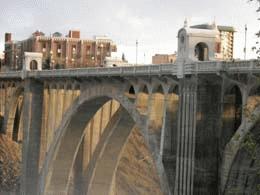On the weekend of September 16-18, 2005, Spokane celebrates the opening of the reconstructed Monroe Street Bridge, which spans the dramatic Spokane River gorge. The new bridge faithfully replicates the venerable third bridge to stand on the site, which at the time of its opening in 1911, was the longest concrete-arch bridge in the United States. The reconstruction, with the same graceful arches, remains a marvel of beauty and functionality, “a major transportation link and a revered symbol of our community” ("Bridging the Past ...,"
Spokesman-Review
), and “Spokane’s premier character-defining landmark” (Holstine and Hobbs). The reconstruction retains the aesthetic elements of the earlier bridge, while improving strength and safety for a long future of heavy use.
The third Monroe Street Bridge replaced a steel bridge, which in turn had replaced a wooden bridge built in 1890. The concrete-arch bridge opened to acclaim on November 23, 1911. It was both spectacular and functional, and truly represented a home grown achievement: City engineers designed it and supervised its construction, the local architectural firm of Kirtland Cutter and Karl Malmgren provided the elaborate ornamentation, and Spokane day-labor crews built it. More than 3,000 people attended the opening.
By the 1990s the beautiful and iconic bridge was deteriorating so badly that frequent repairs no longer sufficed to keep it viable. A new bridge was needed, but “saving [the original] wasn’t always the idea; in fact, for quite some years the idea was to replace the current bridge” (Compau, 1).
Fortunately, community consensus eventually favored a replica or rehabilitation rather than a new design. In January 2003, the bridge was closed for restoration under the engineering and construction management firm of David Evans and Associates. Spokane watched, fascinated, as the old bridge was dismantled and the new rose in its place. The new bridge looks like the old, with the same overall design and with the Cutter and Malmgren ornaments faithfully replicated. The improved pedestrian walkways still provide unsurpassed viewing points for the spectacular falls of the Spokane River.
The reconstructed bridge has human as well as aesthetic and structural ties to the original. Stephen Shrope, engineer of record for the project, declared: “This is much more personal [than other jobs]. I’m a Spokane boy. My grandparents were here and alive when it [the 1911 bridge] was built” (Spokesman-Review, September 17, 2005). Thus, the new Monroe Street Bridge spans not only the river but also the generations. It is basically the same beloved bridge, but better, with an anticipated lifetime of at least 75 years.

